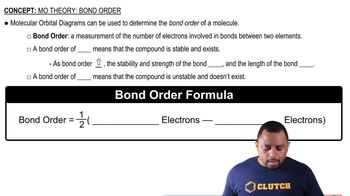Consider the Lewis structure for glycine, the simplest amino acid:
(c) What is the total number of s bonds in the entire molecule, and what is the total number of p bonds?

 Verified step by step guidance
Verified step by step guidance



Consider the Lewis structure for glycine, the simplest amino acid:
(c) What is the total number of s bonds in the entire molecule, and what is the total number of p bonds?
(a) Write a single Lewis structure for N2O, and determine the hybridization of the central N atom.
In the sulphate ion, SO42-, the sulphur atom is the central atom with the other 4 oxygen atoms attached to it. (b) What hybridization is exhibited by the S atom?
In the formate ion, HCO2-, the carbon atom is the central atom with the other three atoms attached to it. (c) Are there multiple equivalent resonance structures for the ion?
In the formate ion, HCO2-, the carbon atom is the central atom with the other three atoms attached to it. (d) How many electrons are in the p system of the ion?